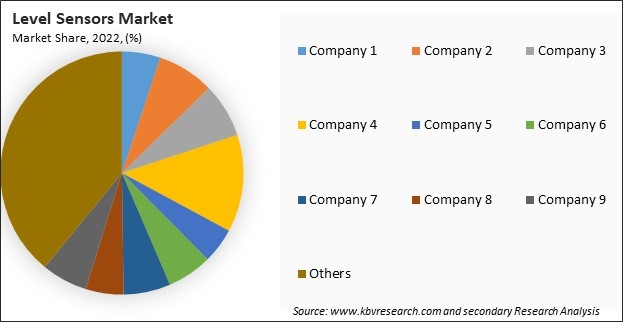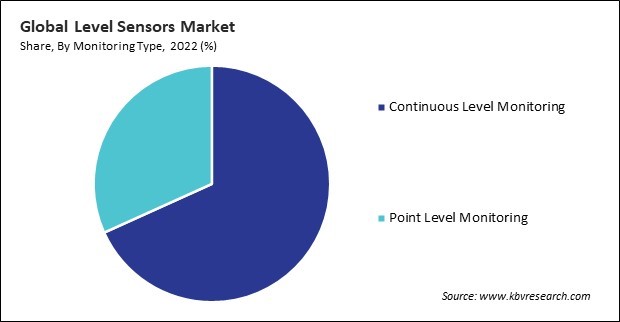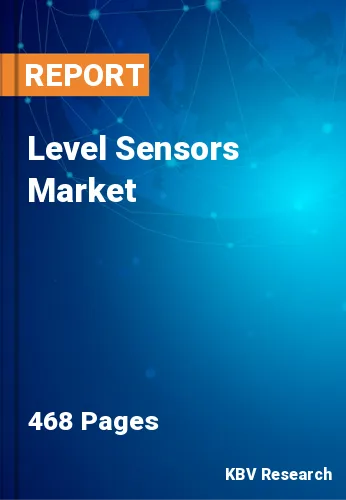“Global Level Sensors Market to reach a market value of USD 9.6 Billion by 2030 growing at a CAGR of 8.7%”
The Global Level Sensors Market size is expected to reach $9.6 billion by 2030, rising at a market growth of 8.7% CAGR during the forecast period. In the year 2022, the market attained a volume of 34432.2 thousand units, experiencing a growth of 12.1% (2019-2022).
The increasing use of level sensors in the chemical and pharmaceutical industries is driven by the need to ensure safety, optimize processes, manage inventory, control quality, comply with regulations, and save costs. Consequently, the chemical & pharmaceuticals segment would generate approximately 19.70% revenue share of the market by 2030. Also, U.S would utilize 7,849.1 thousand units of level sensor in continuous level monitoring by 2030. Level sensors are essential components of automated manufacturing systems in the chemical and pharmaceutical industries.

Sensor technology advancements have transformed how industries monitor and control the levels of various substances. One significant advancement is the development of noncontact level sensors, which use ultrasonic, radar, or laser to measure the distance to the material surface without physical contact. Another key advancement is the integration of smart technology into level sensors. Hence, these technological advancements will support the growth of the market in the coming years.
Additionally, the food and beverage (F&B) industry is a multifaceted and ever-changing sector that holds significant importance in economies across the globe. In the United States, iconic brands like Coca-Cola, PepsiCo, McDonald's, and Starbucks dominate the market. Level sensors empower manufacturers to enhance operational excellence through the provision of real-time data pertaining to inventory levels and process parameters.
However, the substantial financial outlay and ongoing upkeep obligations linked to level sensors may present considerable obstacles for the market. One of the most immediate impacts is reduced adoption rates, particularly among smaller businesses with limited budgets. These high costs can deter potential buyers, slowing the market's growth. Thus, the high initial investment and maintenance costs associated with level sensors can have a range of negative impacts on the market, including reduced adoption rates, limited market growth, competitive disadvantages, and stifled innovation.

The leading players in the market are competing with diverse innovative offerings to remain competitive in the market. The below illustration shows the percentage of revenue shared by some of the leading companies in the market. The leading players of the market are adopting various strategies in order to cater demand coming from the different industries. The key developmental strategies in the market are Acquisitions, and Partnerships & Collaborations.
Based on technology, the market is characterized into contact and non-contact. The non-contact segment procured a 53.70% growth rate in the market in 2022. Noncontact level sensors can remotely monitor substance levels, allowing for real-time data collection and analysis. This capability is particularly useful in applications with limited or hazardous access to the measurement point. Additionally, these sensors typically require less maintenance than contact sensors, as there are no moving parts that can wear out or become damaged.
The contact segment is further segmented into guided wave, magnetostrictive, hydrostatic, magnetic & mechanical float, pneumatic, and others. The guided wave segment recorded a 27.38% revenue share in the market in 2022. Guided wave sensors work on the principle of guided wave radar, where a probe or waveguide is inserted into the tank, and guided waves are sent along the probe. The waves interact with the surface of the material being measured, and the time taken for the waves to reflect to the sensor is used to determine the level of the material. These sensors are compatible with various process conditions, including corrosive materials, high temperatures, and high pressures.
The non-contact level segment is further divided into ultrasonic, microwave/radar, and others. The ultrasonic segment garnered a 52.14% revenue share in the market in 2022. The sensor emits high-frequency sound waves (typically 20 kHz to 200 kHz) that travel through the air and are reflected by the material's surface. The sensor then calculates the time the sound waves return and uses this information to determine the distance to the material's surface. The ability of these sensors to quantify liquids, solids, and slurry substances renders them applicable to industries, including food & beverage, chemical processing, and water treatment.
On the basis of monitoring type, the market is classified into continuous level monitoring and point level monitoring. The point level monitoring segment recorded a 31.75% revenue share in the market in 2022. In terms of volume, point level monitoring segment has 12,111.6 Thousand units in 2022. Point-level monitoring, which involves detecting the presence or absence of material at a specific level within a tank or vessel, is crucial in various industries to ensure safety, prevent spills, and automate processes. In addition, point-level monitoring helps optimize inventory management, preventing overstocking or stockouts.

By end user, the market is divided into industrial manufacturing, oil & gas, wastewater, chemical & pharmaceuticals, consumer, and others. The industrial manufacturing segment witnessed a 31.05% revenue share in the market in 2022. Level sensors can monitor the quality of materials used in manufacturing processes. By ensuring that materials are at the correct level and free from contamination, level sensors help maintain product quality. These sensors are essential components of automated manufacturing systems.
Free Valuable Insights: Global Level Sensors Market size to reach USD 9.6 Billion by 2030
Region-wise, the market is analyzed across North America, Europe, Asia Pacific, and LAMEA. The North America segment recorded a 28.68% revenue share in the market in 2022. The need for efficient water and wastewater management systems drives North America's demand for level sensors. These sensors are used in water treatment plants, sewage systems, and industrial wastewater facilities to monitor and control levels. Furthermore, North America's oil and gas industry relies heavily on level sensors for measuring levels in storage tanks, pipelines, and refineries.
| Report Attribute | Details |
|---|---|
| Market size value in 2022 | USD 5 Billion |
| Market size forecast in 2030 | USD 9.6 Billion |
| Base Year | 2022 |
| Historical Period | 2019 to 2021 |
| Forecast Period | 2023 to 2030 |
| Revenue Growth Rate | CAGR of 8.7% from 2023 to 2030 |
| Quantitative Data | Volume in Thousand Units, Revenue in USD Billion, and CAGR from 2019 to 2030 |
| Number of Pages | 468 |
| Number of Tables | 920 |
| Report coverage | Market Trends, Revenue Estimation and Forecast, Segmentation Analysis, Regional and Country Breakdown, Porter’s 5 Forces Analysis, Company Profiling, Companies Strategic Developments, SWOT Analysis, Winning Imperatives |
| Segments covered | Technology, Monitoring Type, End User, Region |
| Country scope |
|
| Companies Included | TE Connectivity Ltd., Siemens AG, Sensirion AG, Emerson Electric Co., ABB Ltd., Ametek, Inc., Honeywell International, Inc., Fortive Corporation (Fluke Corporation), Texas Instruments, Inc., Amphenol Corporation |
By Technology (Volume, Thousand Units, USD Billion, 2019-2030)
By Monitoring Type (Volume, Thousand Units, USD Billion, 2019-2030)
By End User (Volume, Thousand Units, USD Billion, 2019-2030)
By Geography (Volume, Thousand Units, USD Billion, 2019-2030)
The Market size is projected to reach USD 9.6 billion by 2030.
Technological Advancements in Level Sensors are driving the Market in coming years, however, High Initial Investment and Maintenance Costs restraints the growth of the Market.
TE Connectivity Ltd., Siemens AG, Sensirion AG, Emerson Electric Co., ABB Ltd., Ametek, Inc., Honeywell International, Inc., Fortive Corporation (Fluke Corporation), Texas Instruments, Inc., Amphenol Corporation
In the year 2022, the market attained a volume of 34432.2 thousand units, experiencing a growth of 12.1% (2019-2022).
The Continuous Level Monitoring segment is leading the Market by Monitoring Type in 2022 there by, achieving a market value of $6.5 billion by 2030.
The Asia Pacific region dominated the Market by Region in 2022 there by, achieving a market value of $3.8 billion by 2030.
Our team of dedicated experts can provide you with attractive expansion opportunities for your business.

 Drivers
Drivers
 Restraints
Restraints
 Opportunities
Opportunities
 Challenges
Challenges
